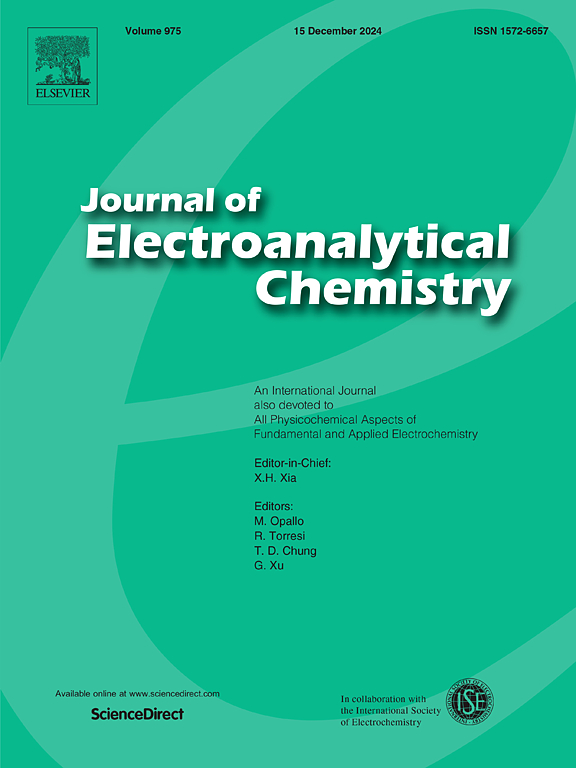Potential-controlled structural evolution of Bromobenzene on Au(111): Insights from in situ STM
IF 4.1
3区 化学
Q1 CHEMISTRY, ANALYTICAL
引用次数: 0
Abstract
The adsorption behavior of bromobenzene (BrB) on an Au(111) electrode was investigated using in situ scanning tunneling microscopy (STM) under potential control in 0.1 M sulfuric and perchloric acid solutions. Real-time STM imaging revealed that BrB adsorption induced immediate structural changes on the Au(111) surface, including the formation of 2.3 Å deep vacancy islands (VIs) and predominantly disordered BrB structures. The preferential interaction of BrB with Au adatoms, rather than the Au(111) terrace, likely drove VI formation. As the potential increased, BrB coverage expanded, leading to a structural transition from 1D molecular chains to 2D arrays, and eventually to a well-ordered 3D multilayer film. Concurrently, the BrB molecular orientation shifted from a flat-lying to an upright configuration. At positive potentials, the multilayer BrB film remained structurally stable but dissolved upon a negative potential shift and irreversibly decomposed at more negative potentials. Additionally, BrB assembled differently in perchloric acid, highlighting the critical role of anions in interfacial organization. Local linear BrB structures preferentially aligned along the 〈121〉 direction of Au(111), forming triangular fractal patterns and an increasingly disordered 3D film at positive potentials.
溴苯在Au(111)上的电位控制结构演化:来自原位STM的见解
采用原位扫描隧道显微镜(STM)研究了电位控制下Au(111)电极对溴苯(BrB)在0.1 M硫酸和高氯酸溶液中的吸附行为。实时STM成像显示,BrB吸附引起Au(111)表面立即发生结构变化,包括2.3 Å深空位岛(VIs)的形成和主要无序的BrB结构。BrB与Au原子的优先相互作用,而不是Au(111)阶地,可能驱动了VI的形成。随着电位的增加,BrB覆盖范围扩大,导致结构从1D分子链转变为2D阵列,最终转变为有序的3D多层膜。同时,BrB分子的取向也从平躺的形态转变为直立的形态。在正电位下,多层BrB膜结构稳定,但在负电位下溶解,在更多负电位下不可逆分解。此外,BrB在高氯酸中的组装方式不同,这突出了阴离子在界面组织中的关键作用。局部线性BrB结构优先沿Au(111) < 121 >方向排列,形成三角形分形图案,并在正电位处形成越来越无序的3D膜。
本文章由计算机程序翻译,如有差异,请以英文原文为准。
求助全文
约1分钟内获得全文
求助全文
来源期刊
CiteScore
7.80
自引率
6.70%
发文量
912
审稿时长
2.4 months
期刊介绍:
The Journal of Electroanalytical Chemistry is the foremost international journal devoted to the interdisciplinary subject of electrochemistry in all its aspects, theoretical as well as applied.
Electrochemistry is a wide ranging area that is in a state of continuous evolution. Rather than compiling a long list of topics covered by the Journal, the editors would like to draw particular attention to the key issues of novelty, topicality and quality. Papers should present new and interesting electrochemical science in a way that is accessible to the reader. The presentation and discussion should be at a level that is consistent with the international status of the Journal. Reports describing the application of well-established techniques to problems that are essentially technical will not be accepted. Similarly, papers that report observations but fail to provide adequate interpretation will be rejected by the Editors. Papers dealing with technical electrochemistry should be submitted to other specialist journals unless the authors can show that their work provides substantially new insights into electrochemical processes.

 求助内容:
求助内容: 应助结果提醒方式:
应助结果提醒方式:


